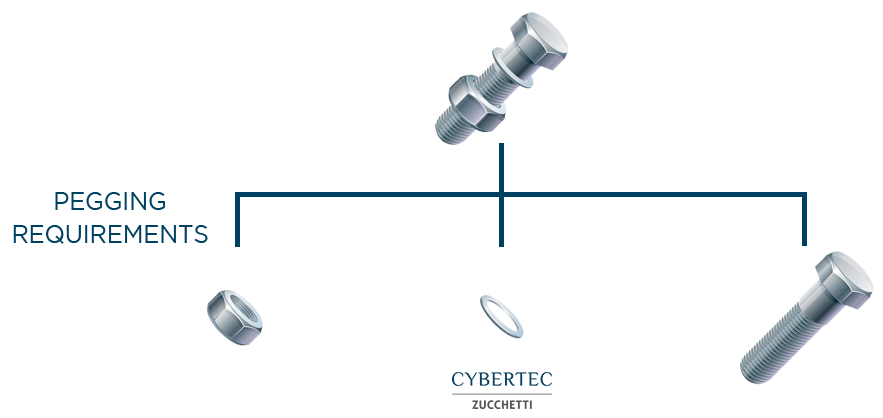Pegging is a very important aspect, within MRP solutions, for several reasons. The benefits of pegging, in fact, are reflected in planners but also in the supply chain in general. Let’s find out why.
Whatis MRP pegging?
Pegging in the MRP field means the possibility of going back to the independent needs that have generated a specific purchase or production proposal. Thanks to pegging, therefore, the planner is able to understand which sales orders the purchased materials correspond to. This aspect is particularly important in cases where the bill of materials has many levels and therefore risks having excessive purchase quantities due to any reordering policies.
Pegging allows the planner to track supply and demand level connections between different levels of the same supply chain, including initial demand (sales orders or forecasts), all purchase and supply orders, and all planned production orders.
What MRP pegging is for
Pegging allows the production planning department to understand the connections between dependent production orders (or external purchase orders) and independent production orders and consequently allows for related benefits.
Thanks to pegging, the planning department can carry out analysis of reordering policies and optimise component purchases. Purchase orders are often exaggerated in terms of the size of the reorder lots. The effects of these estimation errors propagate to the purchase materials and inflate the quantities needed at each bill of material level. The information provided by pegging, on the other hand, makes it possible to distinguish between the quantity that is actually used for acquired sales orders and that which will instead be stored as stock.
Pegging is also useful for managing delivery delays thanks to the fact that it allows the production planning department to understand what availability should be anticipated, in case of delays. In the face of a delivery delay, in fact, it is possible to see which production orders satisfied the products considered and therefore a choice of prioritisation can be made.
With pegging it is possible to have greater visibility about the expected delivery date to the customer. Pegging data allows you to trace all production and purchase orders linked to a specific order, and allows you to make reminders and/or reconsider the expected time for delivery.

The benefits of pegging
Thanks to pegging, manufacturing companies and in particular production planning departments can benefit from:
- transparency and visibility in the Supply Chain and in the relationships between different elements;
- multi-level planning to coordinate the different elements of the production chain;
- identification of the materials available on multi-level production scenarios.
The benefits of pegging do not stop there but are reflected in other aspects, such as the better management of delivery dates to the customer and the management of materials for the satisfaction of priority orders.
A great advantage of pegging is also that, even in the MTS (Make To Stock) scenario, it is possible to know exactly which dependent production order or purchase order satisfies which independent production order. For example, a planned order or a production order may satisfy a sales order. If the required components are made available late, you can quickly see which orders need to be postponed and which customers need to be notified.
The two types of pegging: dynamic and fixed/static
There are two different types of pegging: dynamic and fixed (or static). With the first type of pegging, dynamic pegging, the system deletes existing pegging relationships and creates new ones. Consequently, with dynamic pegging, the assignment of an incoming or in-stock component can be re-discussed, in case of changes to the plan.
If you use static or fixed type pegging, on the other hand, you can assign and “fix” the receipt of a certain material or component to a specific order. The system cannot modify fixed type pegging relationships on its own.
CyberPlan and MRP pegging
CyberPlan’s MRP provides both types of pegging seen above, dynamic and static, allowing its combined use in a production plan. Given the pegging relationships already created previously (treated in CyberPlan as “links” between questions and availability), the user can decide which are fixed (“frozen links”) and which are free to be re-discussed in subsequent re-planning sessions. The flexibility extends to the detail of the individual question, which may have some pegging relationships fixed and others modifiable by the system.
During the execution of the MRP, the fixed bonds are maintained while the free ones are eventually deleted or moved, or new ones are added, depending on the balance preferences set: all this in order to best meet the current needs.
Finally, the navigation functions of the pegging links allow you to easily aggregate multilevel pegging relationships by displaying them as if they were direct relationships, e.g. between a purchase component and a finished product that may actually have different intermediate levels of semi-finished products.
Equip your production planning department with tools that allow you to see the pegging
Learn how to evolve the tools used by your company’s production scheduling department. Today you can equip your department that deals with production scheduling with a tool that allows you to visualize and analyze the connections between employee and independent orders, pegging. Thanks to these solutions, you can free your planners from repetitive and low-value tasks to take care of decisions with higher added value. Contact a supply chain expert ready to advise you and resolve any doubts, to find out which may be the most suitable solution for you.
